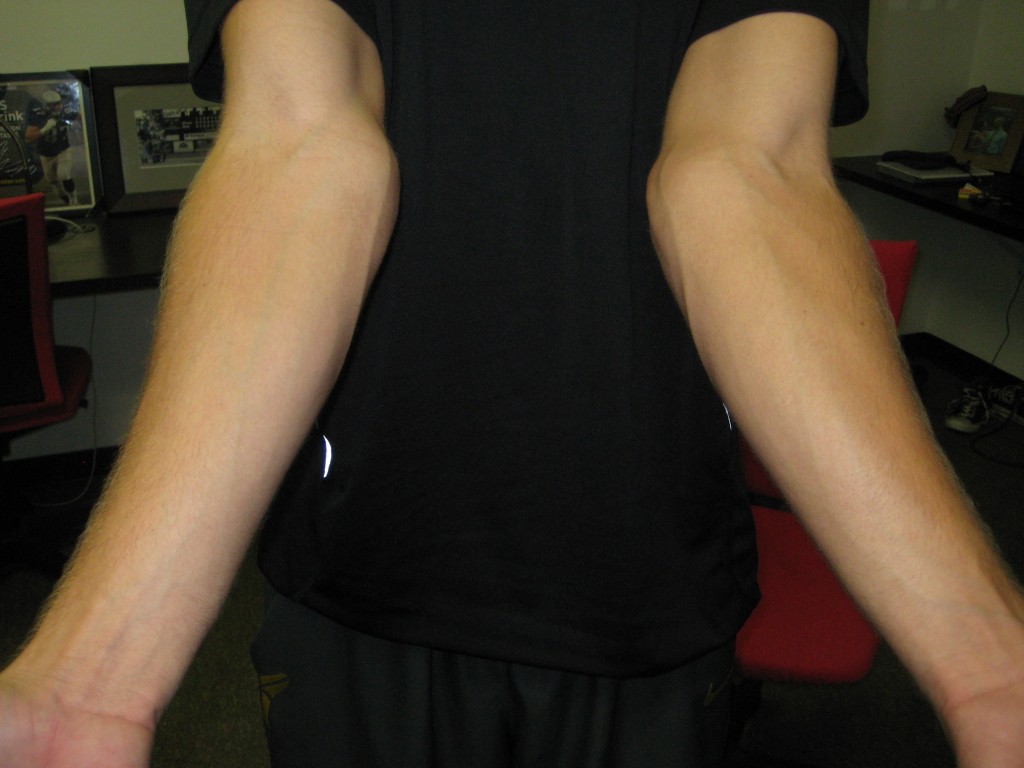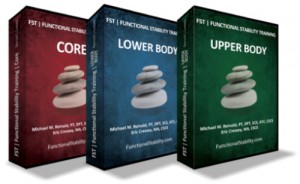Functional Stability Training of the Upper Body
I mentioned the other day that Mike Reinold and Eric Cressey released their new video product on Functional Stability Training: Upper Body, which is the third installment of their Functional Stability Training trilogy. I’ve written about their previous components, both on the Lower Body and the Core, and this one lives up to their same standards of excellent information delivered in a very realistic and actionable manner. It’s an ideal educational product for personal trainers, athletic therapists, physical therapists, chiropractors, doctors, and anyone looking to work with people who are engaged in performance-based or rehab-based training programs, as well as those who are involved in general fitness and want to get the most out of their training programs.
I wanted to beak down a couple of the key concepts they cover during the series, as I finally got a chance to sit down and go through some of it.
- If you’re moving in one direction, you’re stabilizing in the other two planar directions. Just because a biceps curl exists in the saggital plane doesn’t mean that’s all that’s going on. To keep the shoulder in place and resist the forces of the weight, internal muscular contractions, and a bunch of other stuff going on at once, the muscles have to stabilize in the frontal and transverse plane simultaneously.
- Mike has way better graphics than Eric in his presentations, but Eric has way funnier jokes and memes, making him automatically more professional on the internet.
- Slouching reduces shoulder flexion range of motion by 18 degrees. This is completely secondary to anything that happens within the shoulder joint itself, which means the thoracic spine has as much to do with shoulder health as anything we do directly to the shoulder joint.
- Lateral epicondylitis (tennis elbow) had significant decreases in pain and significant increases in grip strength (without pain) by working on scapular positioning. We can hammer home on the elbow all we want, but the problem could be coming from up stream and pissing down onto the elbow.
- Laxity is different from mobile, and very different from instability. Instability involves some level of previous pathology, such as an injury, and is typically in one specific direction, whereas laxity can be multidirectional and not be problematic. Fibromyalgia is also more common in those who are highly lax versus chronically stiff. Maybe there’s a connection to muscles always being “on” to control the mobility which leads to pain?
- Getting people to neutral is easy, but learning to keep them there is the challenging thing, especially as you add external forces in multiple different planes.
- Putting an arm into a layback position puts 64 Newton-meters of force on the medial elbow, but the UCL (ligament that holds the medial elbow together) will give out at 32 Newton-meters in cadaver sections, which means throwers are playing a game of Russian Roulette with their throwing mechanics. This is especially prevalent since a story came out of a high school player who apparently threw for 192 pitches in a game the other day. Likely he’s doing all the right things to need surgery in the future.
- The ulnar nerve can subluxate with flexion and extension of the elbow in some people, especially with valgus force on the elbow. If you’re doing pushups and your elbow dives in, you’re potentially grinding your ulnar nerve.
- “Brutally short” and “disgusting” are two phrases I’ve never heard before in discussing the lats, but are now going to be in my normal rotation.
- excessive range of motion is more of a concern than too little range of motion
- As much as trainers think they can replicate physical therapy, they can not. There’s a completely different end of the continuum that trainers have no experience in, and therapists thrive in. Use them well and they help make your job easier.
- Most people will do T-spine extension work without considering where they’re getting the extension from. Most of the time, if the thoracic spine is sticky, the majority of the movement will come from the T-L junction, presenting with a gigantic rib flare in the front. Keep the ribs down and make sure the extension comes from where you want it to.
- Tony just randomly takes his shirt off even before being asked. He likes being shirtless.
[embedplusvideo height=”379″ width=”625″ editlink=”http://bit.ly/T9i2kH” standard=”http://www.youtube.com/v/71m1m0hbavI?fs=1″ vars=”ytid=71m1m0hbavI&width=625&height=379&start=&stop=&rs=w&hd=0&autoplay=0&react=1&chapters=¬es=” id=”ep5521″ /]
The live demos and discussions in this product are far and away the biggest jump these guys have made from the previous versions, and I’ve always been better at learning from looking over someone else’s shoulder. About half of the videos are live demo breakdowns and assessments, which is hugely valuable to see two similar but clinically different approaches to the same thing.
Until Sunday you can pick up the Functional Stability Training: Upper Body video series for $20 off. If you want to pick up the entire trilogy (hint: PICK UP THE ENTIRE TRILOGY!!!), you can get that when you hit the “ORDER NOW” button and looking at the option on the right of the screen. Don’t want the entire set? That’s cool, you can get each component separately.
===> Click HERE for more info and to get your copy <===



One Response to Functional Stability Training of the Upper Body